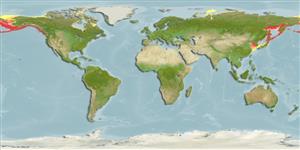Environment: milieu / climate zone / depth range / distribution range
Ökologie
seewasser demersal; tiefenbereich 0 - 325 m (Ref. 6793). Temperate
North Pacific: Sea of Japan and the Sea of Okhotsk to the Chukchi Peninsula and Norton Sound, Alaska to Kiska Island in the Aleutian chain and southeastern Alaska.
Size / Gewicht / Alter
Maturity: Lm ? range ? - ? cm
Max length : 28.0 cm TL Männchen/unbestimmt; (Ref. 56557); common length : 19.5 cm TL Männchen/unbestimmt; (Ref. 56557); max. veröff. Gewicht: 240.00 g (Ref. 56557); max. veröff. Alter: 12 Jahre (Ref. 56557)
Rückenflossenstacheln (insgesamt) : 9 - 11; Rückenflossenweichstrahlen (insgesamt) : 13 - 16; Afterflossenstacheln: 0; Afterflossenweichstrahlen: 14 - 18. A few bony plates usually present on median line of interorbital space (Ref. 559). Supraocular cirrus absent in adults (Ref. 559). Three pairs of bony tubercles on occiput (Ref. 559). Cleithral spine not developed (Ref. 559). In males, spatulate cirri present on pectoral axil (Ref. 559).
Life cycle and mating behavior
Maturities | Fortpflanzung | Spawnings | Egg(s) | Fecundities | Larven
Eschmeyer, W.N., E.S. Herald and H. Hammann, 1983. A field guide to Pacific coast fishes of North America. Boston (MA, USA): Houghton Mifflin Company. xii+336 p. (Ref. 2850)
IUCN Rote Liste Status (Ref. 130435)
Bedrohung für Menschen
Harmless
Nutzung durch Menschen
Tools
Zusatzinformationen
Download XML
Internet Quellen
Estimates based on models
Preferred temperature (Ref.
123201): -1.2 - 6.4, mean 1.7 °C (based on 722 cells).
Phylogenetic diversity index (Ref.
82804): PD
50 = 0.5078 [Uniqueness, from 0.5 = low to 2.0 = high].
Bayesian length-weight: a=0.00891 (0.00562 - 0.01412), b=3.08 (2.94 - 3.22), in cm total length, based on LWR estimates for this species & (Sub)family-body (Ref.
93245).
Trophic level (Ref.
69278): 3.1 ±0.26 se; based on food items.
Widerstandsfähigkeit (Ref.
120179): mittel, Verdopplung der Population dauert 1,4 - 4,4 Jahre. (tmax=9-10;k=0.2-0.4).
Fishing Vulnerability (Ref.
59153): Moderate to high vulnerability (46 of 100).
